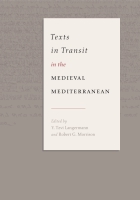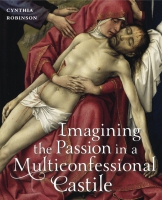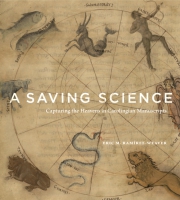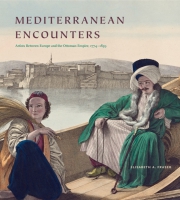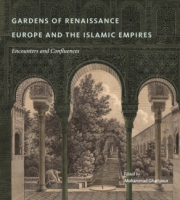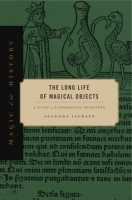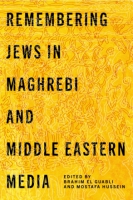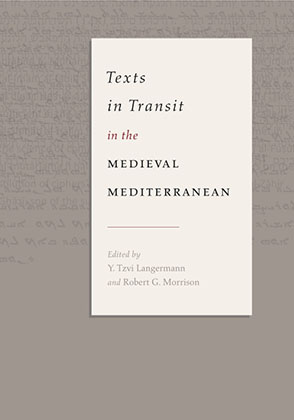
Texts in Transit in the Medieval Mediterranean
Edited by Y. Tzvi Langermann and Robert G. Morrison
Texts in Transit in the Medieval Mediterranean
Edited by Y. Tzvi Langermann and Robert G. Morrison
“Texts in Transit is a pathbreaking collection of original studies, mostly in the history of science and medicine, that trace the transmission of written and oral texts around the Eastern Mediterranean basin in the Middle Ages. Each essay considers how the texts were shared, altered, and preserved as they moved between cultural milieus. Theoretically sophisticated, the studies represent cutting-edge research and offer original interpretations of the journeys taken by these texts.”
- Description
- Reviews
- Bio
- Table of Contents
- Sample Chapters
- Subjects
Transit and transformation give texts new subtexts and contexts, providing windows through which to study how memory, encryption, oral communication, cultural and religious values, and knowledge traveled and were shared, transformed, and preserved. This volume broadens how we think about texts, communication, and knowledge in the medieval world.
Aside from the editors, the contributors are Mushegh Asatryan, Brian N. Becker, Leonardo Capezzone, Leigh Chipman, Ofer Elior, Zohar Hadromi-Allouche, B. Harun Küçük, Israel M. Sandman, and Tamás Visi.
“Texts in Transit is a pathbreaking collection of original studies, mostly in the history of science and medicine, that trace the transmission of written and oral texts around the Eastern Mediterranean basin in the Middle Ages. Each essay considers how the texts were shared, altered, and preserved as they moved between cultural milieus. Theoretically sophisticated, the studies represent cutting-edge research and offer original interpretations of the journeys taken by these texts.”
“How did knowledge travel from one culture to another in the Middle Ages? Scholars increasingly appreciate that in parallel to the main vectors—texts, notably translations, transmitted in manuscripts—there were other, more elusive modes of transmission. This volume aims to draw attention to the phenomenon and identify some of these modes. The eleven studies by scholars from various specialties and countries shed new light on an important but underestimated cultural phenomenon.”
“Tzvi Langermann and Robert Morrison are to be congratulated for bringing together this wide-ranging collection of essays relating to philosophical, religious, and scientific exchange in the Jewish-Musllim-Christian Mediterranean of the Middle Ages. The papers are rigorous and technical but the conclusions are far-reaching, and the volume will be of use to scholars in a variety of fields.”
“While I would most readily recommend this title to those with a particular interest in the study of the medieval Eastern Mediterranean, the studies contained within, through a close and rigorous analysis of understudied texts, offer provocative lessons about the possibilities for the transit of medieval text, knowledge and culture, and should stimulate the thinking of any medievalist, cultural historian, or philologist.”
Y. Tzvi Langermann is Professor of Arabic at Bar-Ilan University.
Robert G. Morrison is Professor of Religion at Bowdoin College.
Contents
Y. Tzvi Langermann and Robert Morrison, “Introduction”
Robert Morrison, “The Role of Oral Transmission for Astronomy among Romaniot Jews”
Ofer Elior, “Rabbi Yedidyah Rakh on Ezekiel's ‘I Heard’: A Case Study in Byzantine Jews' Appropriation of Provencal-Jewish Philosophy and Science”
Tzvi Langermann, “Gradations of Light and Pairs of Opposites: Two Theories and their Role in Abraham Bar Hiyya's Scroll of the Revealer”
Leigh Chipman, “Cryptography in the Late Medieval Middle East: From Mosul to Venice?”
Leonardo Capezzone, “On Memory: From the Humanism of pseudo-Ibn Al-Muqaffa’ to the Science of pseudo-Jabir Ibn Hayyan”
Brian Becker, “Riccoldo da Montecroce’s Epistolae V commentatoriae de perditione Acconis, 1291 as Evidence of Multi-Faceted Textual Movement in the Eastern Mediterranean”
Zohar Hadromi-Allouche, “Narratives of the ‘Second Fall’ in Jewish, Muslim, and Christian Sources”
Mushegh Asatryan, “Shi‘i Underground Literature between Iraq and Syria:
‘The Book of Shadows’ and the History of Early Ghulat”
Tamás Visi, “Medieval Hebrew Uroscopic Texts: Transmission of Scientific Knowledge from Byzantium to Ashkenaz?”
Israel M. Sandman, “The Transmission of Sephardic Scientific Works in Italy”
Harun Küçük, “Medical Translations and the “Hikmet-i Tabiyye” Problematic in Eighteenth-Century Istanbul”
Bibliography
Index
The present volume originated in conversations between us as we had both been working, individually, for several years on the exchange of knowledge in the medieval Eastern Mediterranean. Because these intellectual exchanges crossed borders, languages, and modern academic specialties, we realized that teamwork and international collaborations might yield insights that would otherwise escape our own specialized fields of interest. We assembled the contents of the volume from a call for papers; the volume’s focus on the history of science and its intersection with religious thought is the result of our own research interests and networks. In our earlier research, we have done much to bring to light previously unknown texts that add depth and dimension to our understanding of the exchange of knowledge along the Mediterranean rim. Still, we know all too well that there remains a wealth of texts that are unstudied—or at best inadequately integrated into general appraisals. While there have been other studies of the intellectual history of the medieval Mediterranean, there is plenty of room for the contents of the studies contained in the present volume.1
We have chosen to describe the location of these intellectual exchanges as the medieval Eastern Mediterranean, but we recognize that the presentation of the Mediterranean as a unified region that facilitated commercial activity—this is Goitein’s portrayal—has been questioned.2 The present volume presumes neither that the Mediterranean (or Eastern Mediterranean) was a unified cultural space nor that intellectual exchanges always went smoothly. After all, the Mediterranean has proven harder and harder to define for recent scholars,3 and political instabilities in parts of the Mediterranean have been found to shift merchant networks to other parts of the region.4 Still, “Mediterranean” is an apt descriptor, because the intellectual exchanges found in this volume—exchanges that include elements of Jewish, Muslim, and Christian cultures—are characteristic of the Mediterranean region. Our choice of the term “Mediterranean” does not imply that other regions of the premodern world were less cosmopolitan, but it suggests that the (Eastern) Mediterranean appears to be cosmopolitan in a particular way.5
Our knowledge of the ideas developed, discussed, and debated in times past comes principally from writings that have reached us. These writings may be long books or short treatises, comprehensive volumes or highly focused monographs. They may still be accessible to us because generation after generation saw in them substance and value and continued to copy and, later, to print them; alternatively, they may by chance have survived in some obscure collection. At times only segments of a text have endured, often embedded in other, more appreciated texts, as quotations or allusions. The text may survive in its original language, or in a translation, or in a translation from a translation; it may be extant in both original and in translation, or in translation alone. At one or more stages in its journey, the text may have been transmitted, in part or in whole, orally. That is to say, a human became a text on legs, and a text with a mouth, whose reporting (and interpretation) was heard by a pair of ears and set down again in writing. Then again, we may have nothing but a translation embedded as a quotation, or as a paraphrase, in a different text. Sometimes, only the memory of a text remains. Texts, the repositories and mouthpieces for the entire spectrum of human culture, have transited the centuries, the oceans and continents, and the variety of human languages, in all of these modalities.
Texts, then, play a critical role in the preservation of human cultures, most especially their intellectual achievements. In addition, we can learn from them about communication between different cultures—their efforts to learn from, or to impose ideas on, one another. Texts are also the key instruments for communicating a shared heritage among scattered communities belonging to the same faith or ethnos; texts are the medium for preserving knowledge for future generations. The study of all of these themes in the production, preservation, and communication of knowledge begs for theoretical formulations, models that apply to a wide variety of historical instances. As in the natural and exact sciences, theory must be grounded in close observations of a sufficient number of cases. We are conscious of how, in the social sciences and humanities, theory sometimes must be reined in by the evidence, and influential theoretical models can cause scholars to overlook important evidence. Hence, as historians, we prefer weak versions of theories. We approach the data with theoretical considerations in mind, but do not allow existing theories to assert full hegemony over all of the data. Above all, we aim for insights about the nature of the texts themselves and of their transits. History is not an exact science; the available evidence must be read not only with philological rigor but also with imagination. Judiciously applying creative historical interpretation to new or forgotten texts, we hope to make a significant contribution to the history of texts, their contents, and their transits.
The present collection aims principally to carry out philological and historical studies on the transit of texts in the Mediterranean basin, but theoretical considerations are not ignored. The various ways in which these transits occur do call to mind models that are now very much in vogue. For example, having an earlier text embedded as a quotation or paraphrase in a later text is a form of intertextuality. When texts transit, they are read with new subtexts and contexts. The transits of texts give rise to new texts linked to the prototext through metatexts. Perhaps some may detect paratexts in some of the case studies we present. However, it remains to be seen just how much new and useful knowledge is created or revealed by adding more Greek and Latin prefixes to the term “text.” No less important is the risk that these terms may elide very significant questions about textual transit. By delving deeply into the storehouse of unstudied texts, focusing mainly on content and context, this collection presents new evidence that broadens how we think about texts and their transits.
Because this volume does not aim to define the Mediterranean rigidly, the region’s nuances and complexities provide an ideal locus for investigating this volume’s central concern, the understandings, movements, and exchanges of texts. The numerous case studies in the volume show that the texts themselves were more fluid and had complex sources. As bifurcations between Christian and Islamic societies as well as Western and non-Western science are otherwise tempting, the volume’s focus on the Mediterranean forces the reader to resist such facile classifications. In the Mediterranean, the paths of texts’ transits were neither the most direct nor unidirectional. Older conceptions of textual transmission implied a telos or directionality that is, really, the result of hindsight; the concept of transmission also suggested a fixed, discrete text.
The contributions presented in this volume reject the naïve presumption that texts simply travel, easily detected, without transforming in transit. As Brian Becker has found, reports of texts’ transit themselves had metaphysical import. And even when written texts played the dominant role (Tamás Visi, Israel Sandman), separating out the strands of the prototexts in the transited text has required impressive work. Some contributions (Robert Morrison) note the distinct role of oral texts, and the related valorization of memory (Leonardo Capezzone), in oral exchange. Mushegh Asatryan reminds us of the importance of the piecemeal transit of early texts, embedded as quotations or paraphrases in later ones. Others (Brian Becker, Ofer Elior) have found correspondence to be the only extant record of texts’ transits. If communications were encrypted (Leigh Chipman), then the correspondence would transmit the contents of a text on encryption. Finally, Harun Küçük has found that the transit of Paracelsian medicine from Europe to the Ottoman Empire was heavily determined by human and contextual factors. A similar point is made by Zohar Hadromi-Allouche, in her study of Qurʾanic passages, and Tzvi Langermann, in his investigations into the theories of light and paired opposites. But there is far more to each contribution than the abovementioned way(s) in which each author disrupts easy assumptions about texts’ transits.
Robert Morrison’s contribution describes and analyzes the understudied Hebrew version, produced during the reign of Sultan Mehmed the Conqueror (1432–1481), of an important Arabic astronomy text composed in the first half of the thirteenth century. The author of the Hebrew version, Moses ben Elijah Galeano, explained that the text was transmitted to him orally, predominantly in Turkish. The result was a text that corresponded neither to the Arabic original nor to one of the commentaries on the original. In fact, neither the author’s name nor the title (al-Mulakhkhaṣ fī al-hayʾa by Jaghmīnī) is reproduced accurately in the Hebrew version. Moreover, Galeano included in his Hebrew book a list of planetary apogees that is not to be found at all in Jaghmīnī, and transited to Galeano from some other source. Citing an old Hebrew proverb, Galeano indicates that he held oral testimony in higher regard than written testimony. Thus, even in this case where excellent written evidence exists, the historical actors themselves looked beyond the written record to oral accounts, which, in turn, shaped the surviving written record.
Another contribution on an exchange of texts for which the extant written record is excellent is Ofer Elior’s study of the correspondence of Rabbi Yedidyah Rakh, a figure associated with the island of Rhodes, with Rabbi Michael Balbo of Candia, then capital of Crete. Their correspondence concerns Maimonides’s interpretation of Ezekiel’s visions. In effect, Rakh reopens the question of whether the heavenly spheres emit sounds. Maimonides, relying ultimately on Aristotle, rejected that notion in his Guide for the Perplexed (2.8). While Rakh appreciated Maimonides’s Aristotelian interpretation, he ultimately rejected it, preferring instead to offer an explanation for how sounds could be produced in the heavens. From Rakh’s correspondence, we learn more about how Byzantine Jews received material from coreligionists in the Iberian Peninsula and Provence, which, as Elior observes, are the points of origin of the sources to which Rakh refers. Measured against the science arriving in the Byzantine zone from Iberian and Provençal Jews, Rakh’s account was not that sophisticated. Nonetheless, his correspondence is an important source for the intellectual history of Byzantine Jewry, more specifically the Jewish community on Rhodes during the fifteenth century. Here the original versions of the texts are known; it is their transit that is complicated by the intellectual milieu into which they were received. Elior has shown how important individuals are to the transit of texts, an insight confirmed in the studies of Harun Küçük, Tzvi Langermann, and several others in this volume.
Tzvi Langermann’s essay studies the presence and combination of two arcane theories in Scroll of the Revealer (Megillat ha-Megalleh), an eschatological work by Abraham Bar Ḥiyya (Barcelona and environs, eleventh century). One theory posits gradations of light, from near-divine metaphysical light down to the visible light sensed here on earth. The other views all of reality grouped into pairs of opposites. Both of these theories have their pedigrees in Greek philosophy, and both have known various instantiations and occasional combination in early medieval texts. Langermann finds much in common between Bar Ḥiyya’s theory of light and a statement in Philo of Alexandria, or some obscure but unmistakable allusions to theories of light in Maimonides. Similarly, Bar Ḥiyya’s theory of paired opposites bears striking resemblance to an early (and perhaps sectarian) Jewish text, Midrash Temurah, as well as a text by the earliest writer of the Ismailiyya, a Shia sect. Solid lines of transmission cannot be drawn, but this is not necessarily a fault of the historical record. Rather, the ways in which these theories took shape in Bar Ḥiyya’s book reflect the ways in which texts, or certain ideas contained within texts, transited in Late Antiquity and the early medieval period. Bar Ḥiyya, like many or most writers of his time, took the texts that transited his way, in whatever form they may have reached him (as a written book, a passage in a book, or simply an idea passed on orally) as belonging to the inventory of ideas, to be drawn upon and adapted as needed. A creative writer working before the basically Aristotelian outlook of Jewish philosophy had been fixed by Moses Maimonides, he produced his own combination of the two abovementioned theories.
The texts, even when extant, can be cryptic. Leigh Chipman traces migrations of cryptographic techniques through the Middle East into Europe. First, Chipman examines how theories about cryptography found in twelfth-, thirteenth-, and fourteenth-century Mamluk cryptography treatises in a Süleymaniye Codex appeared in encryptions of poetry and prose. In a way, the encryption of poetry, though lacking in practical applications, was no surprise, as premodern cryptography required a great sensitivity to language. One cryptologist studied by Chipman discussed encipherment in languages besides Arabic, including Mongolian, Armenian, Latin, French, Turkish, and Hebrew. More generally, cryptography was a means by which texts could transit undetected, and Chipman speculates that cryptography served diplomatic purposes, particularly in multilingual Mosul. Chipman proposes a number of ways in which this knowledge could have spread west, where identical cryptographic techniques emerged later. These techniques would not have to travel via a text on cryptography, but only through an enciphered text, just as science and technology could be transmitted through instruments and diagrams (in addition to scientific texts).
Memory, the subject of Leonardo Capezzone’s chapter, played an integral role in conceptions of what a text had been in the past. Pseudo-Ibn al-Muqaffaʿ’s text on memory from al-Adab al-ṣaghīr shows how the emergence of a culture of the written text affected the valorization of memory. Intellectual histories produced within premodern Islamic societies depended on memories of what earlier civilizations had contributed, and, as such, these histories could be vehicles for political vindication. As memory was a topic of medical investigation, passages from Rufus of Ephesus’s work on memory were quoted by Muḥammad b. Zakariyyā al-Rāzī in Kitāb al-Ḥāwī; subsequently, a source for the activities of the mind was Nemesius of Emesa’s De natura hominis, and these ideas were developed within the circle of Jābir ibn Ḥayyān. Post-Antique debates about memory effected the inclusion of memory within the activities of the soul. But some of these changes were also a result of choices of terminology as Late Antique texts transited into new languages. Thus the re-presentation of ancient texts on memory informed the Jabirian corpus’s view about how one came to know. It is not surprising, then, that memory became a virtue. In addition, Capezzone shows how remnants of texts’ transits can take centuries to emerge; a similar point is made by Mushegh Asatryan. Capezzone’s point about the mediating role of memory is relevant as well to Moses ben Elijah Galeano and his comment about the superiority of oral testimony, discussed by Morrison.
Brian Becker’s study of textual transit in Riccoldo da Montecroce’s Epistolae investigates not only how these letters are an important source for cultural exchanges in the medieval Mediterranean but also what these letters tell us about the movement of books around the Mediterranean. Thirteenth-century Italy saw a flowering of interest in Arabic and Islamic culture; Riccoldo’s mission was shaped by Arabic and Islamic knowledge that had already traveled west. He was able to consult the Qurʾan in the original Arabic. Becker argues that the study of texts is a pilgrimage in itself. Thus, it was all the more tragic when Christian texts fell into non-Christian hands, something Riccoldo observed particularly amid the loot taken by Muslims to Nineveh after the fall of Acre. Getting the texts back was akin to ransoming slaves. The loss of the texts paralleled the loss of territory. The physical text, its integrity, and its possession took on religious significance.
Many themes and narratives in the Qurʾan and its satellite literature bear unmistakable resemblances to parallel themes in Jewish and Christian texts, and it has long been—and, after all is said, still remains—a basic working assumption of academic scholarship that texts, at the very least oral versions of them, transited from the heartlands of the older “Abrahamic” traditions to the Hijaz, where they then found their way into the Islamic tradition. However, some glaring differences between the traditions call for a different explanation. Zohar Hadromi-Allouche homes in on a few significant points, found in Shia literature in particular, where no convincing parallels are evident. These are (1) the identification of the “forbidden fruit” as wheat; (2) barley as a degenerate form of wheat, its baseness due to its origin in the very place of the “tree” from which the wheat was taken; and (3) a very gendered account of authority and transgression, with Eve’s sin consisting in disobeying Adam (rather than God) and trespassing in the male-dominated spheres of fertility and nurturing.
These three themes are by and large absent from ancient Jewish and Christian sources. It is most plausible that the themes found in the Islamic sources are polemical responses to Greek or Zoroastrian traditions, or both. In Greek myths associated with Demeter, wheat and nurturing are governed by female goddesses; the Islamic traditions, which connect them to the Fall, seem thus to be a polemic repudiation of the Demeter myths. Demeter rituals were common enough into the sixth century to make this interaction a historical possibility. In the Dēnkard, barley is a divine gift—a blessing, not a punishment. However, the gender element is not found in the Zoroastrian sources. Still, the Islamic tradition may be responding in part to Zoroastrianism as well. The wheat/barley motif appears (in different forms) in a Jewish text from the Tosafists of northern France as well as in a Welsh poem; both date approximately to the thirteenth century. This odd case may just possibly indicate a transit northward and westward of the theme that appears in Shia traditions.
Older texts—or the pieces which, at times, are all that remains of them—transit within other, later texts, which have been fortunate enough to survive in their entirety. Such was the fate of The Book of Shadows (Kitāb al-Aẓilla), one of the earliest writings appertaining to the subgroup within the Shia known as the Ghulat (“extremists,” so called because of their “extreme” views on the divine nature of the imams). The Book of Shadows, along with the rest of the foundational corpus of the Ghulat, was written in Iraq sometime around the turn of the ninth century, but perhaps even earlier. The carriers of its textual remains were writings of the Nusayris, another Shia splinter group that settled (and remain to this day under the name ʿAlawi) in northern Syria. In the first part of his study, Mushegh Asatryan painstakingly identifies the fragments of this text embedded within other texts and establishes the relationship between The Book of Shadows and other early Ghulat texts. Asatryan then identifies a number of themes in The Book of Shadows that are useful for connecting these early texts with other traditions, within the Shia and beyond: the shadow, which is actually a luminous body and first created being; Muhammad as a near-divine being; and a dialogue between the deity and “intellect,” the first hypostasis. Taking another step backward, Asatryan observes a large-scale movement of texts from Iraq to Syria, as well as a nonpolemical relationship with Christianity. Some of these texts have resurfaced only recently, in nonacademic editions prepared mostly by Lebanese scholars, some of whom belong to the Ismailis; others take pains to conceal their identity. Texts transit, fragment, are embedded in other texts, are swallowed up within closed communities; their vestiges resurface after a millennium, allowing modern scholars to piece them together—the texts themselves as well as the histories of their transmission, and their interactions with texts from other traditions, too.
Tamás Visi studies the formation of a specialized literature by the transit of texts. The specialization is uroscopy, an important diagnostic tool in premodern medicine; the texts are early Greek and perhaps ancient Semitic ones as well. Portions of different texts that all deal with the same subject transit into new texts that are entirely devoted to the topic. These new texts in turn engender further research and theoretical formulations—for example, in the theory of colors. They then transit into other languages and cultures.
Visi’s very erudite study has much to say on the micro level as well. Select passages from the medical writings, especially from the Hippocratic corpus, are examined closely. Significantly, some of the passages transmit variant versions that were rejected by Galen in his authoritative commentary to Hippocrates’s Aphorisms. Moreover, Visi offers strong evidence, the first of its kind, for the direct translation of scientific texts from Greek into Hebrew; the dating is uncertain but the movement certainly occurs before the ninth-century mass translation movement from Greek to Arabic. Syriac sources, so important yet so neglected, are also scrutinized.
What happens after a text transits into a particular locale and gains an audience there? In a painstaking study of the Italian copies of a Hebrew calendrical text, Israel Sandman adduces weighty evidence for “community coordinated” production. Although there is no institution, such as a scriptorium, responsible for the manuscripts, close inspection of the extant manuscripts belonging to the Italian family, especially analytical and editorial glosses, reveals a conscientious effort at producing texts of the highest quality. Sandman’s study offers a bold corrective to accepted models of transmission, which grouped those responsible for writing manuscripts into “copyists,” that is, scholars interested in personal study of the text, and “scribes,” hired hands who had no interest in the content of the text. The former would have felt free to intervene in one way or another, thus producing copies that are markedly different from one another. The latter had no cause to interact deliberately with the text, but may have unwittingly introduced or perpetuated errors. Sandman introduces now a third category, “communally organized” copying: copying not done by scholars, but which nonetheless produced standardized texts of a very high quality. Much more painstaking work remains to be done in order to see how common or rare this model was and whether different genres (say, speculative religious texts, touched upon by Sandman in a brief section) tell different stories.
The spread of Paracelsian medicine, or, as it was called in Ottoman realms, “the new medicine” or “chemical medicine,” has attracted much scholarly attention of late. However, there is much more to this story than the transit of some European books to Istanbul and points beyond and their translation and subsequent incorporation into Turkish and Arabic literature. Harun Küçük serves up a panoramic account, dealing with the transit of people (Europeans who knew how to prepare the new chemical compounds, and who relocated to Istanbul), the transit of medicine within the curriculum (moving upward to the highest ranks, concomitant with the valorization of the new medicine), the falling in and out of favor at court of the new treatments, and the makeup and financial rewards of the medical profession. The processes are interrelated and nonlinear. Hence Küçük’s study, for all of the wealth of detail and new hypotheses it offers, remains an exploration in the problematics of this story, rather than the final word—if there is such a thing.
This is a collection of pathbreaking research. The authors feel obliged to reveal the full details behind the transit of texts from one language, geographical locale, cultural or religious group, or epoch to another. The studies do not presuppose knowledge of any language other than English, and they provide translations of texts in other languages (yet another transit, from the sphere of working knowledge to that of historical inspection and reflection). But the close analysis of the texts, without which no firm grasp on the transits is possible, takes the reader at times into philology as well.6 This necessary complexity makes this collection no easy read, but it rewards the reader with findings about the depths at which the transit of texts could take place. Explanations and, where appropriate, theoretical justification for a certain explanation are provided, but they are all rooted in the texts under study. Conclusions of wider import are offered with all the caution necessary.
Mailing List
Subscribe to our mailing list and be notified about new titles, journals and catalogs.
